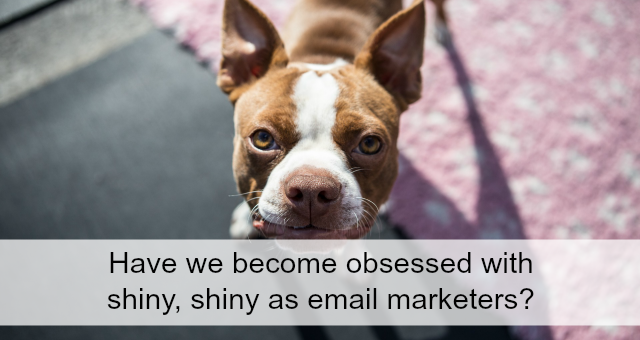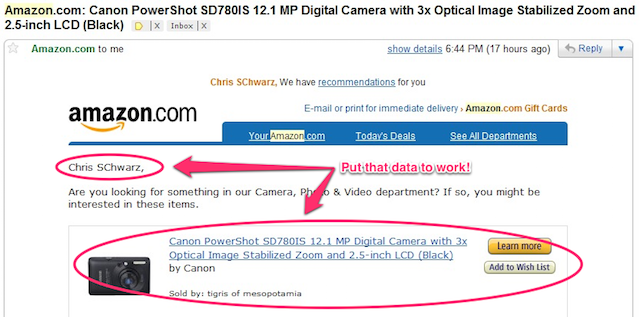 FreshMail
created
FreshMail
created
Have we become obsessed with shiny, shiny as email marketers?
Back to list of articles2017 is an incredibly exciting time for the marketing industry with the rise of AI (artificial intelligence), VR (virtual reality) and AR (augmented reality) to name a few. It’s easy to understand why marketers are a bit distracted! It’s safe to say we all have a keen interest in the next big thing, you only needed to look at the number of brands immediately promoting their products on the craze of Pokémon Go to see we all like to jump on the latest bandwagon.

For email marketers it’s no different. Last year we saw the influx of countdown timers, personalised imagery and now video galore in email campaigns. These are brilliantly effective tools when used in the right way and in the right context but not as effective when used in every email campaign.
Last year I spoke about our obsession of the “shiny shiny”, with marketing Gollum’s running around chasing their precious. It’s been refreshing so far this year to see that several marketing speakers are now coining this phrase. It’s a very valid point because this focus on the next shiny thing is at the detriment of focusing and optimising the basics.
Why are the basics important for email marketing?
Let me start by asking you, when was the last time you reviewed the basics of your email marketing strategy and campaigns? From experience of consulting with a variety of brands I’m going to guess that you probably haven’t reviewed the basics in much detail. At least not since you configured and created your email journeys which could have been 5 or more years ago. Here’s why you should focus on the email basics before you start looking to the next shiny technology that’s available.
Customers engage with the basics
The DMA recently asked consumers what they like from their email they receive and the brand that does email best. Amazon was voted as the brand that sends the best email marketing. After reviewing their email marketing activity, they don’t just include the latest tech because they can, it’s clear to see that for them it’s about defining a clear email strategy that optimises the customers’ journey.

Amazon use customer data to enhance their experience with heavily targeted and personalised campaigns. They send an order confirmation immediately after you’ve made a purchase, request reviews of that product within a couple of days of delivery and send targeted ‘you might be interested in’ styled emails based on your transactional and website behaviour. These are the very basics of email marketing and Amazon do this incredibly seamlessly.
There’s a time and place
Each email campaign you send should have a clearly defined objective, target audience, purpose, and measurement for success all aligned to your overarching email strategy. If you just focus on the tactical element of the content of your email campaigns without a strategy, how will you know that you’re sending to the right audience, at the right time and in the right context?
An email reminder that your sale is ending is a perfect scenario to use a countdown timer, but including this into every email campaign isn’t going to give you the same result. As our attention spans get shorter and shorter to now less of a goldfish, to a mere 8 seconds the same tactical tools effectiveness will wane over time, as they become increasingly utilised. Therefore, these techniques are most effective when used sparingly and in the right context.

The same can be said for the use of emoji’s in email subject lines. Again, these are great at attracting attention but not when used in every single email you send. The attention once paid will wear off.
What works for one, doesn’t always work for all
A couple of years ago, it was discovered that a particular ‘from name’ was the most trusted name in the UK. Guess what… less than a week of that article being published, hundreds of email marketing campaigns featured that same ‘from name’, regardless of whether there was an employee at the company with that same name!
Email marketing is an intelligent art, what will work for your subscribers will be different to the next brand. For B2B organisations having a personalised ‘from name’ can be effective when included after a prospect has had a conversation with a sales representative.
Using their name as the ‘from name’ will instantly create recognition from the reader. However, if you’re a retail brand it might not be as effective because the subscriber will have no affiliation or relationship with that particular person included in the ‘from name’. Testing is the best way to understand the impact a change has to your email marketing.
The performance data that you’re gathering from every single campaign you send will tell you a huge deal about your subscribes, their interests, engagement levels, A/B testing results etc. Rather than it being a guessing game, let the data insights inform your email strategy.
The basics may be the boring part to email marketing, but it’s in setting solid foundations that you can increase your email performance and continue to build upon it. A house built without a solid foundation will eventually always fall over.

